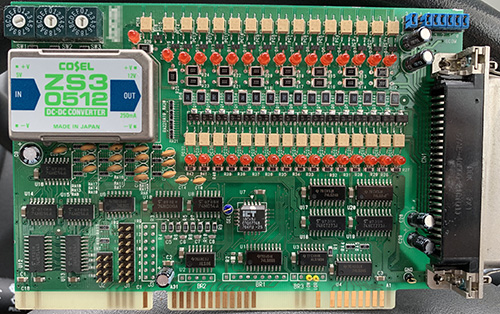The ware for July 2019 is shown below.
ISA, I say! Back in the day when all it took was a couple 7400 series chips to talk to a computer…now we use a small computer just to properly negotiate power before talking for real over standards like USB-C.
Thanks to Nava for contributing this ware, found at Akihabalast, “Akihabara final waste disposal site!”.

16 in+16 out isolated I/O card with some limited IRQ capability (bottom left)
Using three hex rotary switches for the I/O port is kinda neat =) I wonder if the test hooks on GND/SEL/IOR/IOW were standard or if someone added them later for troubleshooting.
Relay control board.
ADTEK aISA-P21 16 DI/DO isolated board
I think this is the correct answer.
I think it is correct that this is the correct answer ;-)
BTW: I had never thought about this before, but yes: Of course you can nowadays buy USB-to-ISA interface adaptors. Yay! One more reason to not throw away ancient ISA cards.
SCSI Adapter
I think this is one of the Contec I/O boards – 16 channel I/O similar to this one https://www.contec.com/products-services/daq-control/pc-helper/isa-card/pio-1616l(pc)v/support/#section
Proprietary card to drive a CNC or Pick & Place machine from a PC.
I don’t think it’s this exact model but here is the instruction manual: https://www.yumpu.com/en/document/read/31726053/pio-16-16lpcv
Opto-Isolated 16 channel I/O board presumably used for some form of industrial automation?
Some notes:
– the connector is a chunky 37 pins – that’s a seriously large cable… the part number pcb37P gives an idea
– I/O address is set via the 3 dials SW1/SW2/SW3
– interrupt is configured by jumpering bottom left jumpers
– 2 of the input signals can be routed to trigger an interrupt
The sample C program on the last page of the manual is fairly minimal. Read/write directly to I/O address – no protected memory!
If I recall, the MS C compiler had a ?macro?function call? to issue INP and OUTP instructions to talk to the Intel I/O port space. With DOS as a real mode “OS”, an ordinary program could use dangerous instructions to read/write directly from/to hardware. Any real OS will immediately fault any program that does such bad things. A lot of (bad) device drivers were written to avoid this safety measure.
Also, in the Bad Old Days, some goofy programmers used the Parallel Port as a bootleg I/O device. Later versions of the hardware were bidirectional, an could actually read and write byte wide, with an extra nibble for handshake.
Today a lot of Pie boards are being sold to replace this board. The GPIO pins act like this thing did.
Today’s modern computer name is microprocessor is it true?
[…] won’t spoil the fun, you can read Bunnie’s post here and the subsequent post on correctly guessed […]